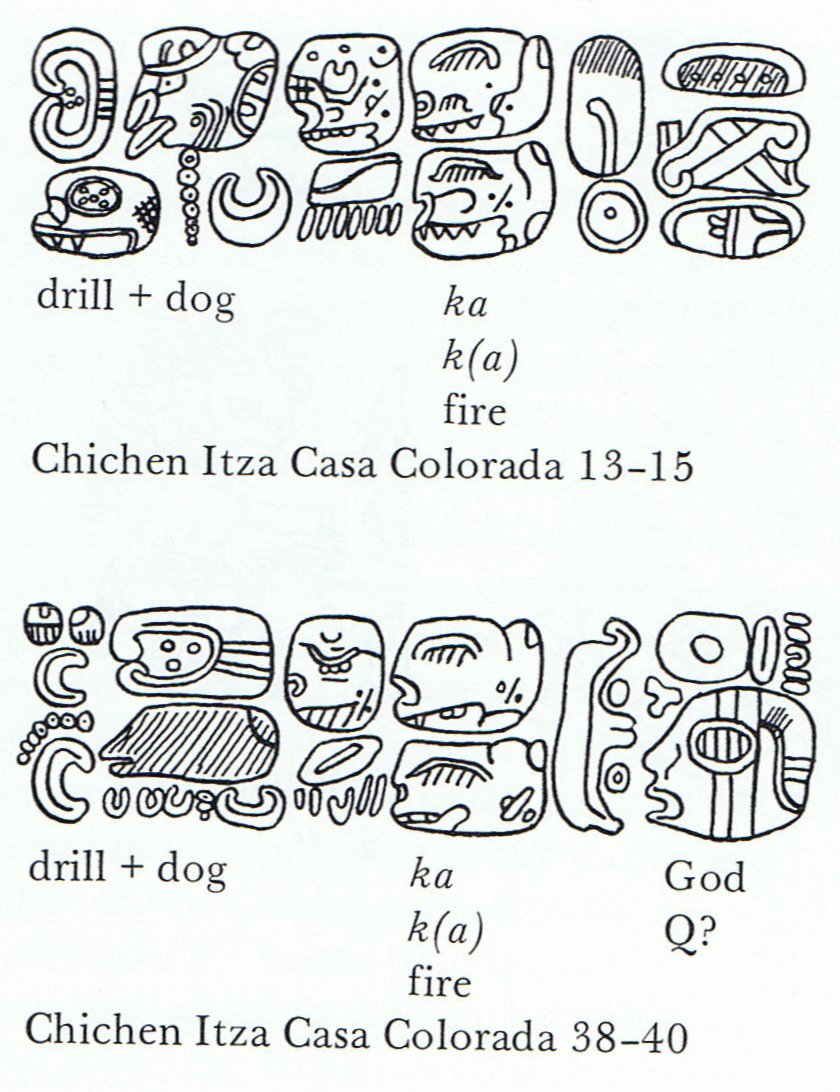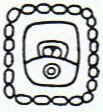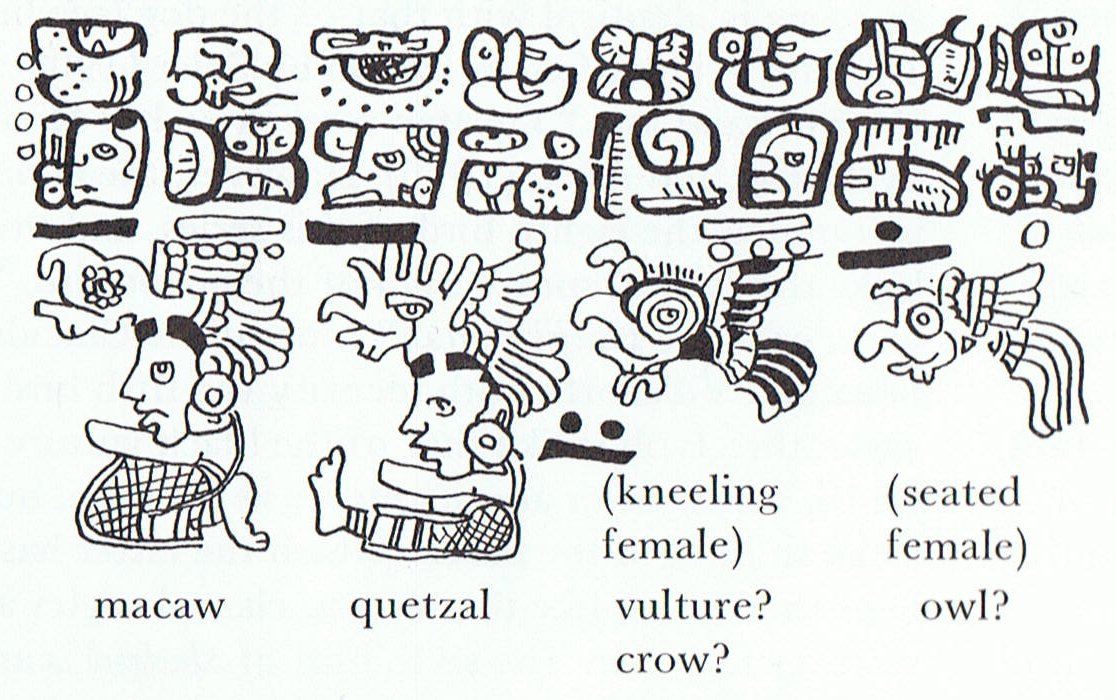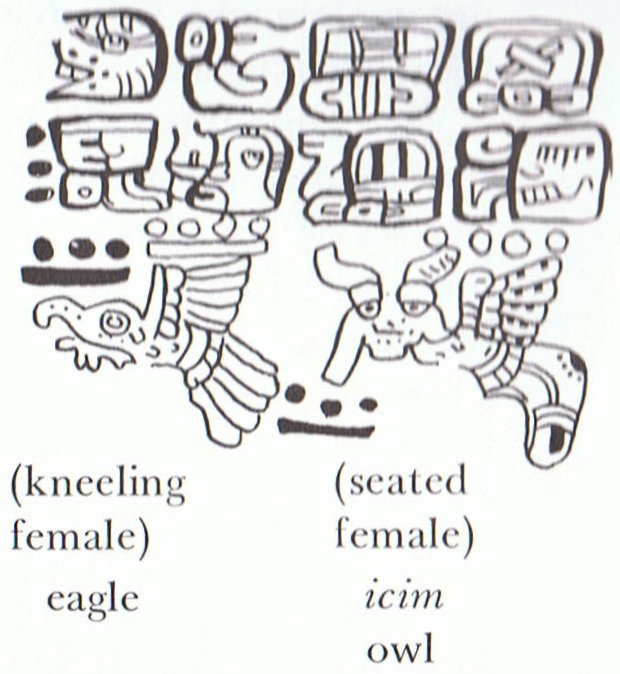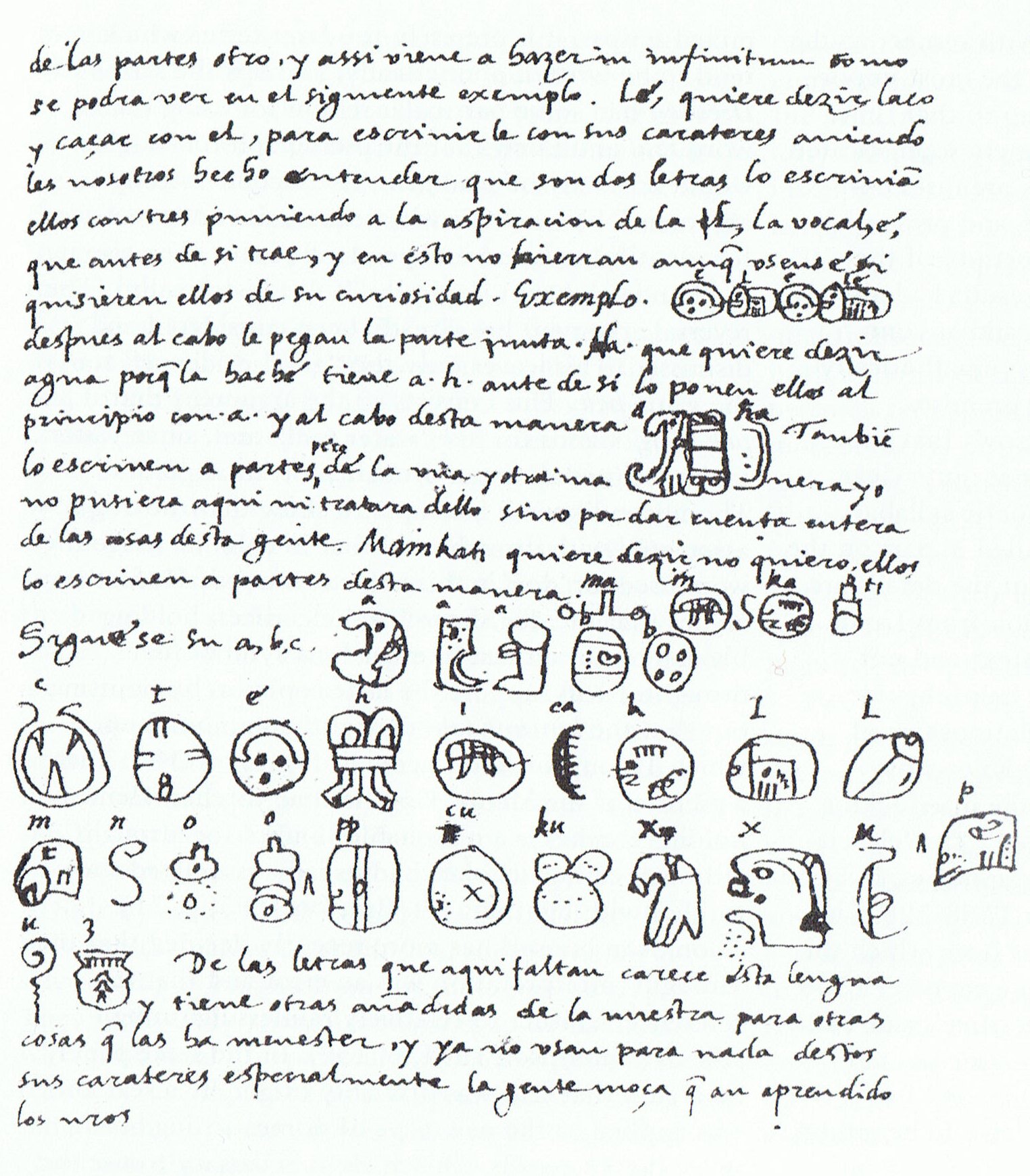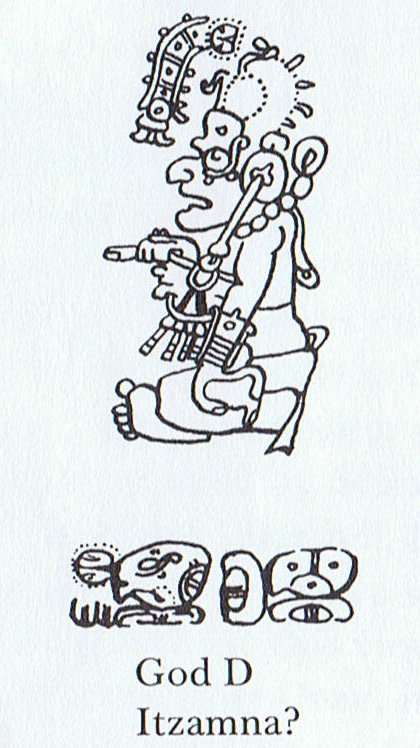|
TRANSLATIONS
If now summer according to G has been firmly mapped, and if haga takaśre is marked by the glyph immediately preceding summer, then it stands at the end of winter:
The changeover from winter to summer occurs in the 7th period, and in the 6th period mago indirectly tells us to 'count':
The fully grown season (tagata) glyph stands at number 84 (counted from Ga1-1, not from Gb8-30), and takaure (Ga4-2) obviously also refers to the fully grown season, with 3 'past' feathers informing us to divide the 84 glyphs by 3, meaning - presuambly - 3 months:
To reach 360 we have to add Ga4-2 (of course) but also the last glyph on side b. The Mayan word xoc (shark) apparently also means 'to count': ... To count the year beginning when sun reappears may be the reason for Zotz (Xoc) meaning both shark, bat and count. The limit is determined by the Pleiades, I guess ... Although on Easter Island the reappearance of Anamua in the morning could have been the determinant of when summer should begin. The shape of Scorpio can be imagined as that of a shark with bent tail: ... From the latitudes of South America (as on Easter Island) the map below must be imagined turned upside down, with the 'fishes' in the lower region:
With the reappearance of the star which announced the arrival of summer any discrepancies between what the calendar told and what you saw with your own eyes must be decided in favour of your own eyes. That may be the reason why xoc means both shark and count. And, we may also infer, the word xoc is probably not connected with the Pleiades but with Scorpio (which, however, should be looked for in the early evening in Maya-land if it should determine the arrival of summer). The month name Zotz does not mean 'shark' but 'bat': ... I cannot see a fish in any of these Zotz glyphs. However, after some time I stumbled on another item: ... the month called Zotz in Yucatec shows a head identifiable as that of a leaf-nosed bat, called zotz in Yucatec ... The so called xoc fish imagined in the zotz glyph refers only to the one in the monumental form, I must conclude:
It is hardly a fish of any sort. It is a composite beast with traces of serpent ('teeth') and bat ('leaf-nose') ... When illustrating the zotz (bat) Kelley gives the following glyphs:
The 'leaves' on the nose of the bat is what catches the imagination. Leaves means that spring is arriving and on the nose means just in front of your eyes. The open mouth means that sky and earth are letting the spring sun in. Now I have arrived at the point where I can move on further along these lines of thought. The birth of summer presumably occurred in 5 (of course) Tzek:
15 Moan was not included by me in what I guessed was summer. The reason was my idea that winter should be cut in half and that each half should have 80 days. Both Moan and Zotz are flying creatures. They belong to the 'sky world'. South of the equator everything is upside down and winter should therefore be defined by water creatures (shark and turtle), an indication that the Mayan xoc could originate from somewhere south of the equator. 8 months of winter cut in half is still possible to imagine. It is just that the cut is not exactly in the middle but somewhat earlier, beyond the 5th day of 19 Vayeb. 20 - 5 = 15 days is like a crack in the carapace of the time turtle. Earlier we stopped the discussions when we arrived at 6 Xul. We should now be ready to continue. Xul depicts a dog and therefore probably refers to Sirius. But the word xul in Mayan means 'end'. We can guess it means the end of winter. In the text of G the end of winter (haga takaśre) appears later than mago (shark). Between Zotz and Xul lies Tzek and - we have earlier guessed - the open top of the glyph indicates 'birth'. First comes an announcement of spring in form of the reappearance of Antares (in Zotz), then the summer season is born (in Tzek), and with the appearance of Sirius (Xul) winter is finished. So it may once have been, I imagine. The time of observing Sirius must be different from that of observing Antares, however. No great problem for such advanced astronomers. In the text of G I cannot see any sign of 'birth', but that may be implicitly understood.
Summer is connected with fire - it becomes hot. If Sirius is telling that summer has arrived, then dogs must be connected with fire. On Easter Island there were no dogs, but Sirius was named Te Pou and according to the kuhane map the star did not announce the arrival of summer but rather the arrival of the new year:
A new year is a new 'fire'. Let us jump over Yaxkin and go to Mol instead:
According to Gates this month sign is the only one which necessarily is surrounded by a circle of dots. From Kelley I have copied these three examples:
On a hill - I try to read the pictures - there stands a construction made by humans. The hill is not only a real hill but also a 'height' in the sky (moon sign, respectively sun sign in the two glyphs at left). The stars are being watched (stones in a circular formation). The construction at the top has two 'apartments', which must refer to the two parts at left and right in time. The constructin at the top is similar to that surrounding what probably is the morning and evening stars in the sign for Venus ('Great Star') - and evidently also for Saturn and stars in Gemini:
The two cartouches at right apparently are being cut - the image of the crack in the carapace have been transformed into cuts in the cartouches. This may be a clue to the meaning of the glyph type hoea (the tattooing instrument):
With 8 (the perfect number) Mol at summer solstice, which I guess is the meaning, there will be 3 months at left and 6 at right if we count only with summer. If we count from 1 Pop there will be 7 months at left and we need to count also 15 Moan in order to reach 7 at right. I believe this is what should be done. Moan belongs to summer in the same way as Zotz belongs to winter, and Mol will be standing in the middle as number 15 (the full moon number). Counting the new year should start at 15 Moan (autumn equinox). In the map of the kuhane number 16 (instead of 15) must mark the 'hill', and it is Poike. Kelley: "Quiche mol 'ring' seems descriptively apt for the glyph." This does not necessarily means the cycle is also completed here, although surely midsummer was sometimes used for that. According to Q noon is the end, the point where the 'pruning' must stop infinite growth: prune1 ... dried fruit of the plum-tree ... prune2 ... trim (feathers) with the beak ... prune3 ... lop superfluous growth from ... Early forms prouyne, proine, pruine ... OF. proignier, earlier prooignier ... Rom. *prōrotundiāre, f. prō- + rotundiāre cut round ... (English Etymology) The Old French proignier sounds suspiciously close to pro - ignier which I would unhesitantly translate into 'for ignition' (without knowing anything about the Old French languages). If you lop too much the tree will die and then its wood will dry and be suitable for fire-wood. If you lop less agressively you will be rewarded by new lush foliage. Foliage comes from Old French too, feuillage, I read in English Etymology. And I know that fire is feu in French. I associate to Kuukuu the planter, which I already early have come to believe is an incarnation of sun. We can now draw a better map for the Mayan months:
Sky comes before earth. With Zotz as 'opener of the way' Moan will be the 'closer of the way'. The necesary dots around the mol sign have not been included by me in the glyph for the month 8 Mol, but we can see them in the 4 following months in the bottom left corners of the glyphs. Then, in 13 Mac a full inversion has relocated them into an upside down position compared with 8 Mol. A slow clockwise revolution. In the glyph for 6 Xul the bottom left corner is instead occupied by what looks like a moon crescent sign surrounded by dots. Let us finish with some more data about Moan (or Muan as he is also named): "The third bird in Madrid is identified as a king vulture by Tozzer and Allen (1910) and as a crow by Villacorta (Villacorta and Villacorta 1930). Seler (1909, IV, 556) has also identified this bird as a vulture.
However, the probable identifying glyph looks like yax. Quiche raxon (from *yax-) is 'blue dove', or a gray bird with blue wings. The fourth bird is very interesting, as the glyger which should correspond to its name is identical with that of the dog (see below). The bird is identified as an owl by Seeler (1902-1923, IV, 612) and as a 'Yucatan screech owl or Moan-bird' by Tozzer and Allen (1910). However, the muan bird is found as the eighth bird of this series, and this bird lacks the typical spotted tail of the muan bird. Villacorta calls it a paujil ('guan'), one of the Cracidae. Seler and Villacorta both identify the fifth bird as an eagle; the glyph is like that of the black vulture of D17b, which Seler also identifies as an eagle, but it lacks an infix in the mouth which the latter has. Perhaps the Mayas, like the Aztecs, classed eagles and vultures together.
The sixth bird of Madrid is an owl, identified by Seler as the muan bird, but by Tozzer and Allen as an icim owl. The first glyger above is apparently that of the owl, although Bartel thinks the second glyph [the one at top right] is that of the owl. He draws attention to the use of this glyger in connection with the muan owls of D7c and D10a (personal communication), but I believe that the true glyph of the muan owl proper in these cases is one which might be read 'Thirteen Heaven' - it is worth noting that the number thirteen is prefixed to the muan bird's head as part of its glyph on D16c.The first glyger in Madrid begins with Landa's i.
The seventh bird is a turkey, but the name glyph, if present, is completely different from the one in Dresden or elsewhere in Madrid.
The final bird is the muan owl, here called only by a title that was normally applied to God D ..." (Kelley)
To say that Moan is a falcon is to mutilate truth. |
||||||||||||||||||||||||||||||||||||||||||||||||||||||||||||||||||||||||||||||||||||||||||||||||||||||||||||||||||||||||||||||||||||||||||||||||||||||||||||||||||||||||||||||||||||||||||||||||||||||||||||||||||||||||||||||||||||
























